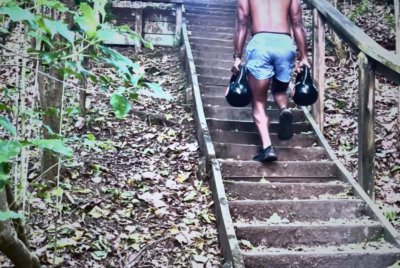Lower Back Pain When Running? Here’s How to Fix It Fast!
If you’ve ever felt that nagging ache in your lower back while hitting the pavement, you’re not alone. As someone who’s spent more time on the trail than I’d like to admit, I know firsthand how frustrating lower back pain can be, especially when running is your go-to stress reliever or fitness routine. So, let’s dive into what’s going on with your back, why it might be acting up, and most importantly, how to keep it from derailing your runs.
Understanding Lower Back Pain
What is Lower Back Pain?
Lower back pain is a common issue that affects many runners. It can range from a dull ache to sharp, stabbing pain and can be caused by various factors. For runners, this pain often results from the repetitive stress that running places on the spine and the surrounding muscles.
Common Causes of Lower Back Pain in Runners
When we run, our bodies go through a series of repetitive motions. Over time, these can cause wear and tear, especially if our form is less than perfect or if we’re pushing ourselves too hard. Common culprits include poor posture, weak core muscles, and even the wrong pair of shoes.
How Running Can Contribute to Lower Back Pain
Running, especially on hard surfaces, can put a lot of stress on the lower back. Each step sends a shockwave through your legs, up into your spine, and if your muscles aren’t strong enough to absorb this impact, your lower back can suffer.
Common Triggers of Lower Back Pain When Running
Poor Running Form
If your running form is off, you’re setting yourself up for all sorts of issues, including lower back pain. Poor form often results from leaning too far forward or backward, not engaging your core, or overstriding.
Inadequate Footwear
Wearing the wrong shoes can throw off your alignment and increase the stress on your lower back. It’s not just about having comfortable shoes – they need to support your specific running style and foot structure.
Lack of Core Strength
Your core muscles, including those in your lower back, are crucial for stabilizing your body as you run. Weakness in these muscles can lead to poor posture and added strain on your back.
Overtraining
Too much running without proper rest and recovery can lead to overuse injuries, including lower back pain. Your body needs time to repair itself between runs, especially if you’re pushing your limits.
Pre-existing Conditions
If you have any pre-existing back issues, such as herniated discs or sciatica, running can exacerbate these problems. It’s important to address these conditions before they sideline you completely.
Preventing Lower Back Pain While Running
Importance of Proper Warm-Up Routines
Warming up before you run is essential. A good warm-up increases blood flow to your muscles and prepares your body for the demands of running. Focus on dynamic stretches that target your lower back and core.
Core Strengthening Exercises
A strong core is your best defense against lower back pain. Incorporate exercises like planks, bridges, and bird-dogs into your routine to build strength and stability.
Tips for Maintaining Proper Running Form
Keep your posture upright, engage your core, and avoid overstriding. It might help to have a running coach assess your form or to film yourself running to spot any bad habits.
Choosing the Right Footwear
Invest in a good pair of running shoes that suit your foot type and running style. Consider visiting a specialty store where they can analyze your gait and recommend the best shoes for you.
Gradual Increase in Running Intensity
Avoid sudden increases in your running mileage or intensity. Gradually build up your endurance to give your body time to adapt to the new demands.
Best Practices for Running with Lower Back Pain

Adjusting Your Running Technique
If you’re already experiencing lower back pain, it’s crucial to adjust your technique. Slow down your pace, shorten your stride, and focus on keeping your back straight.
Incorporating Cross-Training
Cross-training with activities like swimming, cycling, or yoga can help build strength and flexibility without the high impact of running. This can give your back a break while still keeping you active.
Stretching Exercises Before and After Running
Incorporate stretching exercises into your pre- and post-run routine. Focus on stretches that target your hamstrings, hip flexors, and lower back to keep these areas flexible and reduce tension.
Monitoring Your Pain Levels
Pay attention to your body. If your lower back pain is worsening, it’s important to take a break and allow your body to heal. Pushing through the pain can lead to more serious injuries.
Consulting with a Physical Therapist or Trainer
If lower back pain persists, it might be time to consult a professional. A physical therapist can help you identify the root cause of your pain and develop a tailored exercise plan to address it.
Product Recommendations for Lower Back Pain Relief
Top-Rated Running Shoes for Lower Back Pain
– ASICS Gel-Kayano 28: Known for its stability and support, this shoe is a favorite among runners with back pain.
– Brooks Adrenaline GTS 22: Offers excellent arch support and cushioning, reducing the impact on your lower back.
– Hoka One One Bondi 7: Provides maximum cushioning, making it ideal for long-distance runners prone to back pain.
– Saucony Guide 15: A great option for runners who need extra support and cushioning.
– Nike React Infinity Run Flyknit 3: Designed to prevent injuries with its responsive cushioning and supportive fit.
Recommended Foam Rollers
– TriggerPoint GRID Foam Roller: Great for deep tissue massage and relieving muscle tension in the lower back.
– 321 STRONG Foam Roller: Compact and portable, perfect for targeting specific areas of discomfort.
– LuxFit Premium High-Density Foam Roller: Durable and firm, ideal for more intense rolling sessions.
– RumbleRoller Textured Muscle Foam Roller: Its unique design helps penetrate deeper into muscles for effective pain relief.
– ProsourceFit Extra Firm Foam Roller: Provides intense pressure, making it a good choice for experienced foam roller users.
Best Back Braces for Supports
– Mueller Lumbar Support Back Brace: Offers adjustable compression and stability for the lower back.
– Sparthos Back Brace: Lightweight and breathable, it provides excellent support without restricting movement.
– ComfyMed Breathable Mesh Back Brace: Designed for all-day wear, it offers comfort and support for active individuals.
– NeoTech Care Back Brace: Features adjustable straps and lumbar pad for targeted support.
– BraceUP Stabilizing Lumbar Lower Back Brace: Ergonomic design allows for a full range of motion while still providing support.
Pain Relief Creams and Gels
– Biofreeze Pain Relief Gel: Known for its cooling effect and quick pain relief, Biofreeze is a go-to for many athletes dealing with lower back pain.
– Voltaren Arthritis Pain Gel: Though primarily for arthritis, this gel also works well for soothing sore muscles and back pain.
– Tiger Balm Pain Relieving Ointment: A classic remedy that provides a warming sensation to ease muscle and joint pain.
– Penetrex Pain Relief Cream: This cream penetrates deep into the tissues, offering relief from inflammation and pain.
– Sombra Warm Therapy Natural Pain Relieving Gel: Uses natural ingredients to create a soothing, warming effect that helps relieve lower back pain.
Orthotic Inserts for Better Support
– Superfeet GREEN Insoles: These provide maximum support and structure, which can help alleviate lower back pain caused by improper foot alignment.
– Powerstep Pinnacle Arch Support Insoles: Designed to provide firm arch support and cushioning, these insoles help improve foot mechanics, reducing stress on your back.
– Dr. Scholl’s Running Insoles: Specifically engineered for runners, these insoles reduce impact and offer excellent arch support.
– Sof Sole Athlete Insoles: A great all-around insole that provides comfort, support, and shock absorption.
– Spenco Polysorb Cross Trainer Athletic Insoles: These insoles offer superb cushioning and support, making them ideal for runners who experience back pain.
When to See a Doctor
Signs That Your Back Pain May Be More Serious
While lower back pain is common, certain symptoms may indicate a more serious issue that requires medical attention. If you experience numbness, tingling, or weakness in your legs, or if your pain persists despite rest and self-care, it’s time to see a doctor.
The Importance of Seeking Medical Advice
Don’t ignore persistent or severe lower back pain. A healthcare professional can help diagnose the underlying cause of your pain and recommend appropriate treatment options. Early intervention can prevent further damage and help you get back to running sooner.
What to Expect During a Consultation
When you visit a doctor for lower back pain, they will likely conduct a physical examination and may recommend imaging tests such as X-rays or an MRI to get a better look at your spine. Based on the results, they’ll suggest a treatment plan, which may include physical therapy, medication, or other interventions.
Conclusion
Lower back pain when running can be a real downer, but it doesn’t have to stop you from enjoying the sport you love. By understanding the causes of your pain, making necessary adjustments to your running routine, and incorporating supportive products, you can reduce your discomfort and keep moving forward. Remember, the key is to listen to your body and not push through pain. Running should be something that makes you feel good, not something that causes you harm.
FAQs
What are the most common causes of lower back pain in runners?
The most common causes of lower back pain in runners include poor running form, weak core muscles, inadequate footwear, overtraining, and pre-existing conditions such as herniated discs or sciatica.
Can running with back pain worsen my condition?
Yes, running with back pain can potentially worsen your condition, especially if you continue running without addressing the underlying cause. It’s important to rest and seek medical advice if your pain persists.
What type of running shoes is best for preventing lower back pain?
The best running shoes for preventing lower back pain are those that provide proper support and cushioning based on your foot type and running style. Shoes like the ASICS Gel-Kayano and Brooks Adrenaline GTS are often recommended.
How can I strengthen my back to avoid pain while running?
Incorporate core-strengthening exercises such as planks, bridges, and bird-dogs into your routine. These exercises help stabilize your lower back and reduce the risk of pain.
Should I stop running completely if I experience lower back pain?
Not necessarily. If your pain is mild, you can try adjusting your running routine, incorporating cross-training, and focusing on proper form. However, if the pain persists or worsens, it’s best to take a break and consult a doctor or physical therapist.
This article should provide you with a comprehensive guide to dealing with lower back pain when running, with practical tips, product recommendations, and expert advice to help you stay active and pain-free. Remember, every runner is different, so what works for one person might not work for another. Don’t be afraid to experiment with different techniques and products until you find what works best for you!
*We may earn a commission from purchases made through our links, at no cost to you. This does not affect our product recommendations. Please see our disclosure to learn more.
![Urban Health Hive]](https://urbanhealthhive.com/wp-content/uploads/2023/05/cropped-cropped-Health_Logo.png)



